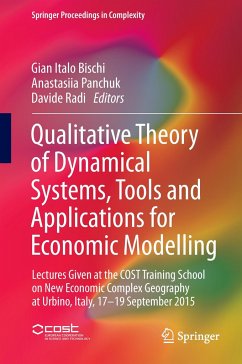
The Economics of Interfirm Networks

PAYBACK Punkte
19 °P sammeln!
This book is one of the first comprehensive works to fill the knowledge gap resulting from the limited number of empirical studies on interfirm networks. The in-depth empirical research presented here is based on a massive transaction relationship database of approximately 400,000 Japanese firms. This volume, unlike others, focuses on the role of interfirm networks in three different fields: (1) macroeconomic activities, (2) economic geography and firm dynamics, and (3) firm-bank relationships. The database for this work is constructed in collaboration with Japan's largest credit research comp...
This book is one of the first comprehensive works to fill the knowledge gap resulting from the limited number of empirical studies on interfirm networks. The in-depth empirical research presented here is based on a massive transaction relationship database of approximately 400,000 Japanese firms. This volume, unlike others, focuses on the role of interfirm networks in three different fields: (1) macroeconomic activities, (2) economic geography and firm dynamics, and (3) firm-bank relationships. The database for this work is constructed in collaboration with Japan's largest credit research company, Teikoku Data Bank, and covers a substantial portion of Japanese firms with information on firms' transaction partners, shareholders, financial institutions, and other attributes, including their locations and performance.
Networks prevail in many aspects of economic activities and play a major role in explaining a wide variety of economic phenomena from business cycles to knowledge spillovers, which has motivated economists to produce a number of excellent works. In the policy arena, there has been a growing concern on the vulnerabilities of networks based on the casual observation that idiosyncratic shocks on firms can be amplified through inter-firm connections and leads to a systemic crisis. Typical examples are the manufacturing supply-chain networks in the automobile and electronics industries which propagated regionally concentrated shocks (the Great East Japan Earthquake and floods in Thailand in 2011) into global ones. An abundance of theoretical literature on the formation and functions of networks is available already.
This book breaks new ground, however, and provides an excellent opportunity for the reader to gain a more integrated understanding of the role of networks in the economy. The Economics of Interfirm Networks will be of special interest to economists and practitioners seeking empirical and quantitative knowledgeon interfirm and firm-bank networks.
Networks prevail in many aspects of economic activities and play a major role in explaining a wide variety of economic phenomena from business cycles to knowledge spillovers, which has motivated economists to produce a number of excellent works. In the policy arena, there has been a growing concern on the vulnerabilities of networks based on the casual observation that idiosyncratic shocks on firms can be amplified through inter-firm connections and leads to a systemic crisis. Typical examples are the manufacturing supply-chain networks in the automobile and electronics industries which propagated regionally concentrated shocks (the Great East Japan Earthquake and floods in Thailand in 2011) into global ones. An abundance of theoretical literature on the formation and functions of networks is available already.
This book breaks new ground, however, and provides an excellent opportunity for the reader to gain a more integrated understanding of the role of networks in the economy. The Economics of Interfirm Networks will be of special interest to economists and practitioners seeking empirical and quantitative knowledgeon interfirm and firm-bank networks.













